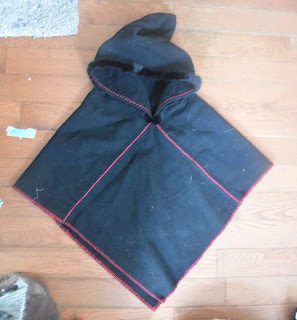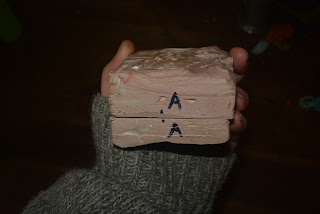
I managed to track these back to the national museum of Iceland, and confirm that they were from the viking era, but that was, sadly, all the information I was able to find on them. I was unable to locate them through the National Museum of Iceland website, or find more information about them on a reverse image search. I could however copy them roughly from the pictures. The thumb is a standard pattern, exactly like the ones on my gloves. it even looked like it might have a gusset extending into the thumb from the hand, based on the seam lines. There was a gore inserted to the outside hand seam to give extra room. So far, so good. I used my glove pattern for a base, and drafted something that looked like it would work.
 I had to decide what fabric to use for these items. The gloves look like tabby weave, and the Skjoldehamn hood was as well. Color is hard to tell without chemical testing. I retreated to the B̶a̶t̶c̶a̶v̶e̶ basement to check the stash for possibilities. I had several likely suspects, all heavily fulled tabby woven wool, in varying shades of brown, and one piece of black. Now I KNOW that black is not even the smallest bit authentic for viking era. But my house's colors are black and red, and I had just acquired several hanks of red crewel wool. I couldn't resist. Besides the black was brushed to the fuzzy delightfullness of fleece on one side, which would be lovely on the interior of the hood and mittens. It was so fleecy that I questioned whether it was 100% wool, and lit a piece on fire. It is, indeed wool. Delightfully warm and beautifully fulled and brushed.
I had to decide what fabric to use for these items. The gloves look like tabby weave, and the Skjoldehamn hood was as well. Color is hard to tell without chemical testing. I retreated to the B̶a̶t̶c̶a̶v̶e̶ basement to check the stash for possibilities. I had several likely suspects, all heavily fulled tabby woven wool, in varying shades of brown, and one piece of black. Now I KNOW that black is not even the smallest bit authentic for viking era. But my house's colors are black and red, and I had just acquired several hanks of red crewel wool. I couldn't resist. Besides the black was brushed to the fuzzy delightfullness of fleece on one side, which would be lovely on the interior of the hood and mittens. It was so fleecy that I questioned whether it was 100% wool, and lit a piece on fire. It is, indeed wool. Delightfully warm and beautifully fulled and brushed.Fabric choice made I traced the mitten pattern onto the fleecy side of the wool with my trusty silver metallic sharpie. (with supervision from Kitten) and cut them out.
The original mitten shows a standard seam at the thumb. I don't like the feeling of that against my hand, even with the seam allowances felled flat, so I overlapped and whip stitched, just like I do on gloves, and the seamed up the finger portion of the seams and felled the sides down flat.
I used the same technique for the rest of the mitten, I overcast the gore on one side, for a decorative touch, then sewed the side seam, opened it flat, and felled it down with a running stitch. I used contrasting thread, and let the running stitch show on the outside. I have mixed feelings about this technique, which is currently quite popular amoung the SCA vikings. I've seen documentable evidence for interior overcast seams with contrasting thread, and herringbone'd hems with contrasting thread that showed on the outside as a double row of running stitch. The seams on the skjoldehamn hood were not felled at all (although the seaming method there tends to let make them lay flat) I tend to think this trend is a reenactorism, but haven't done the research to decide 100% yet. (If anyone has sources to point me at, please do share!) I chose to use it on the gloves because pretty and practical. I hate nubby seams on the insides of things on my hands!
I had to fiddle a little with the shape of the top of the hand, but eventually got something I was happy with. Since I was in a hurry, I just cut the pattern a bit generous, then pinned, seamed, and trimmed to fit. I left the hems unfinished, which is the beauty of fulled wool.
I had decided I wanted to use a decorative seam on the hood. Van dyke stitch is very close to the osenstitch found overworking seams on one of the osberg garments, and it's a relative of the stitch found on the cushion at mammen. It has high plausibility and the advantage of running the seam at the same time as decorating it. (unlike the evils of the decorative members of that family, which is why my kaftan is in time out right now.... ) Van Dyke stitch is easiest if you first hem all the pieces, then work the stitch. So I hemmed all the pieces with a basic overcast stitch, mitering the corners of the front and back squares, and leaving the edges that would make up the hem raw.

Then I pieced it together with van Dyke stitch. Van dyke, with it's cousins, can tend to ease one side of the seam in, causing a lopsidedly bunchy seam when you open and steam it, also ends that do not to line up. So I controlled that with pins. I worked right over the pins, instead of taking them out as I came up to them, forcing the two sides to remain the same length.
I ran out of time, and hemmed in the car, on the way to the event (muttering THIS IS CROOKED the whole way, much to the amusement of the house brother I was riding with) which meant I just got the points hemmed before I wore it, and the face wasn't treated at all. But it worked like a charm, I wasn't exactly TOASTY but neither did I turn into a viking popcicle.
It's hemmed with a overcast stitch, perpendicular to the edge of the fabric, and paralell with the threads of the weave, as in the extant piece. This is more moderately spaced than my last overcast edging, because this wool is too fulled to fray, and therefor It's much closer to the original. I darned the stitches at the points at the front and back on the reverse side, to keep them from spreading.
I finished the hemming, and the stitching inside the hood opening when I got home. I did not stitch the cockscomb onto it, because I liked the fact that I could drop the hood almost over my face. It kept me warmer. I like this hood the way it is now, but am considering using it as a slate for some further embroidery. I think it would lend itself well to some mammen style work front and back, and maybe a pair of maltese crosses on the shoulders, since this is something I will basically only wear when I've put on my leg wraps and gone to war (to paraphrase the saga). The mittens, I decided to be super fancy and trim with a little grey fur.... because... pretty that's why. Caps were trimmed with fur, so I figure the mittens are plausible at least, although I fully admit it is a bit of a stretch.
Then that was so fun and pretty I decided to put a little black fur around the face of the hood. In for a penny in for a pound right? The result is pleasingly pretty, although I can't vouch for the strict historical accuracy of it.
The only problem with the hood, is that it doesn't work well at all with a flat folded cloak. AT ALL. so if I want to wear it regularly I'm going to have to make myself something along the lines of a birka coat to wear with it. If I want to wear a cloak, I'm going to need to make myself a hat.
























